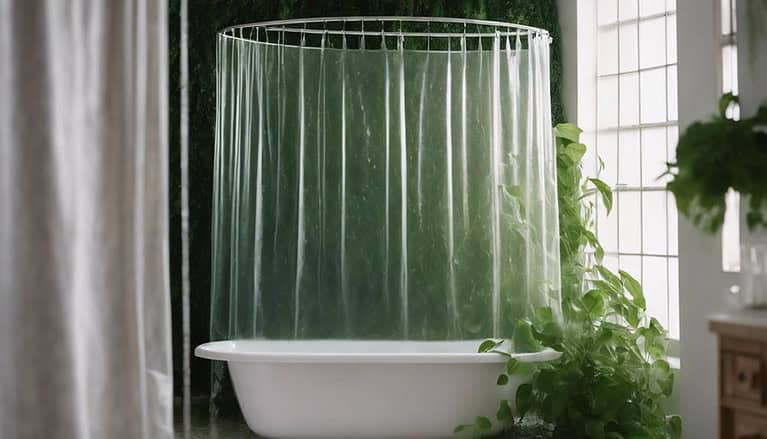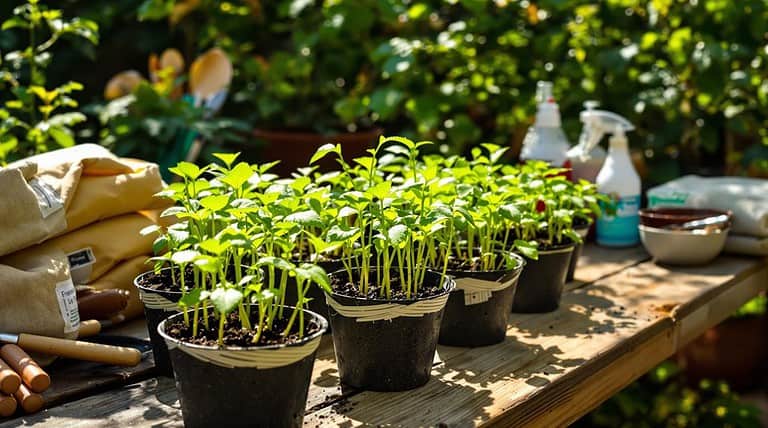Pitfalls of Planting Seeds Too Early
When you plant seeds too early, you’re basically throwing them into a cold, hostile world where frost can kill delicate seedlings overnight, forcing them to start over from scratch. Cold soil below 50°F slows germination, creates weak root systems, and invites fungal diseases that love cool, waterlogged conditions. You’ll also deal with leggy plants from inadequate light, compacted soil that blocks growth, and increased costs from extended care requirements. Stick around to uncover how proper timing changes these challenges into gardening success.
Quick Guide
- Frost exposure kills seedlings by destroying plant cells with ice crystals, forcing plants to regrow and delaying maturity.
- Cold soil below 50°F slows germination and creates weaker root systems that struggle with water absorption.
- Insufficient light conditions produce leggy, weak plants that lack proper structural development and overall vigor.
- Cold, compacted soil promotes fungal diseases and waterlogging while creating hostile conditions that block seedling emergence.
- Early planting increases costs and resource demands while disrupting natural growth patterns and extending recovery time.
Frost Damage Threatens Vulnerable Seedlings

When you’re enthusiastic to get your camping season garden started and plant those seeds way too early, you’re basically rolling out the red carpet for frost damage to crash your seedling party like an uninvited guest with a grudge.
Those tender little seedlings can’t handle freezing temperatures, and ice crystals will literally destroy their delicate cells, leaving you with dead plants instead of fresh camp veggies. Additionally, understanding soil amendments is crucial to ensure that your garden beds are ready for planting once the frost threat has passed. Monitoring canopy cover changes helps you track exactly how much damage frost inflicts on your surviving plants over time.
Stunted Growth From Temperature Extremes
When you’re enthusiastic to get your camping garden started and plant those seeds way too early, you’re basically setting up your future plants for a rough ride through temperature extremes that’ll stunt their growth before they even get a fair shot at life.
I’ve learned this lesson the hard way during my own outdoor excursions – those chilly mornings and scorching afternoons can seriously mess with your seedlings, causing frost damage that leaves them looking like they’ve been through a blender, while the constant temperature swings create a chilling effect that slows down their entire growth process. When soil temperatures drop below 50°F, enzyme operation becomes less efficient, which extends germination time and creates weaker root systems that struggle to establish properly. Additionally, some hardy vegetables, like winter carrots, thrive when planted at the right time to avoid these temperature extremes.
Trust me, there’s nothing more frustrating than watching your carefully planned camp garden turn into a collection of weak, struggling plants because you couldn’t wait for Mother Nature to give you the green light!
Frost Damage Risks
Although you might be enthusiastic to get your seeds in the ground as soon as the snow melts, planting too early can expose your precious seedlings to frost damage that’ll make you wish you’d waited just a few more weeks.
Frost acts like nature’s reset button, killing delicate above-ground tissue and forcing plants to regrow from scratch, delaying maturity considerably.
Chilling Growth Effects
Even if your seeds manage to dodge the worst of the frost damage, cold soil temperatures can still wreak havoc on your garden dreams by fundamentally putting your plants into slow-motion mode, where they’ll struggle to grow properly and might never quite catch up to their full potential.
You’ll end up with wimpy, stunted seedlings that look pathetic.
Inadequate Light Conditions Create Weak Plants

Envision this scenario: you’re super excited about your upcoming camping trip, you’ve got all your gear packed, but then you realize you forgot to charge your headlamp and now you’re stumbling around in the dark trying to set up your tent—that’s exactly what happens to your seedlings when they don’t get enough light! Without adequate exposure, proper light conditions can lead to leggy, weak plants that struggle to thrive.
Soil and Watering Challenges Multiply
When you’re enthusiastic to get your garden started and plant those seeds way too early, you’ll quickly realize that your soil becomes your biggest enemy instead of your best friend.
It refuses to warm up properly and creates a soggy, compacted mess that’s about as welcoming to seeds as a cold, wet sleeping bag is to a camping trip.
Your watering routine turns into a nightmare balancing act where you’re either drowning your poor seeds in waterlogged soil that breeds nasty fungal diseases, or you’re watching helplessly as the soil surface crusts over like concrete, blocking your seedlings from breaking through to see sunlight.
I learned this the hard way when I got overzealous one March and ended up with a garden bed that looked more like a swamp than a seedbed, complete with that lovely smell of rotting seeds that nobody warns you about in those cheerful gardening magazines!
Poor Soil Preparation
Beyond the timing mistakes that plague enthusiastic gardeners, there’s another sneaky culprit that’ll sabotage your seed-starting dreams faster than you can say “harvest time” – and that’s skipping the essential step of proper soil preparation.
When you rush into planting without testing pH, adding compost, or improving drainage, you’re basically rolling out the red carpet for stunted seedlings and disappointed harvests.
Increased Watering Demands
Just as cool morning dew clings stubbornly to your camping gear, making everything feel damp and heavy, those enthusiastic little seeds you’ve planted too early will cling to every drop of moisture they can get – and they’ll demand a whole lot more of it than you’d expect.
You’ll find yourself watering daily because their stunted roots can’t absorb water efficiently, creating a frustrating cycle.
Increased Disease Susceptibility Risks

Although you might think getting your seeds in the ground early gives them a head start, you’re actually setting them up for a world of trouble when it comes to disease susceptibility.
Cool soil creates perfect conditions for fungal pathogens to thrive, while your young plants lack the developed immune systems needed to fight back effectively.
Resource Management Becomes More Demanding
When you plant your seeds too early, you’re fundamentally signing up for a much more complicated and resource-hungry gardening expedition that’ll have you juggling multiple balls in the air like a circus performer.
You’ll need bigger pots, more potting soil, extra fertilizer, increased watering schedules, and extended lighting periods – turning your simple seed-starting setup into a demanding operation.
Equipment and Labor Costs Rise

Because you’ve already committed to extending your growing season with early seed planting, you’re now looking at a financial avalanche that’ll make your wallet feel lighter than a hiker’s backpack after dumping half their gear at base camp.
Your machinery works overtime in harsh conditions, specialized heating equipment becomes essential, and labor hours multiply like rabbits.
Timing Disrupts Natural Growth Patterns
Just like trying to pitch your tent in the middle of a thunderstorm instead of waiting for clear skies, rushing to plant your seeds too early throws your crops completely out of sync with Mother Nature’s carefully orchestrated schedule.
When soil temperatures drop below that sweet spot of 70°F, your seeds basically hit the snooze button, delaying germination and stunting growth permanently.
Recovery Time Delays Overall Harvest

Although your seeds might eventually bounce back from that early planting shock, they’re basically running a marathon with a twisted ankle – sure, they’ll keep going, but they’re never quite catching up to where they should be.
That sluggish recovery pushes back flowering, delays maturity, and ultimately messes with your harvest schedule, leaving you scrambling when autumn arrives.
Wrapping Up
You’ve learned why patience beats enthusiasm when you’re itching to get those seeds in the ground! Remember, rushing your planting schedule creates more headaches than it’s worth, from frost-damaged seedlings to skyrocketing costs that’ll make your wallet cry. Trust me, I’ve been there—waiting for proper conditions feels like forever, but you’ll thank yourself later when your garden thrives instead of struggling to recover from an overzealous start.






